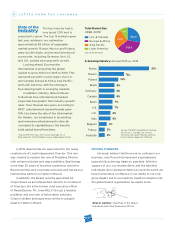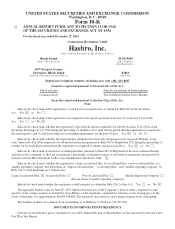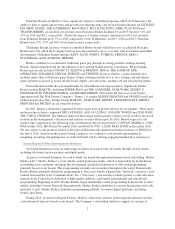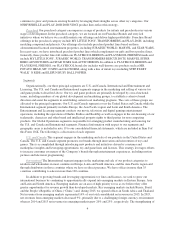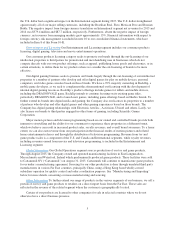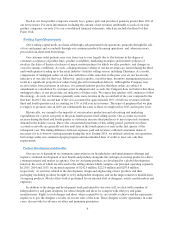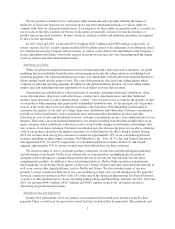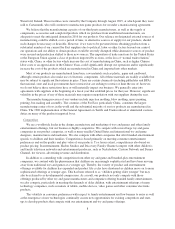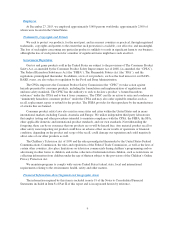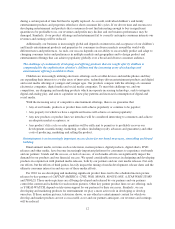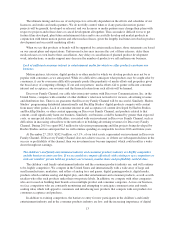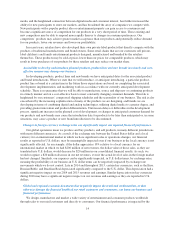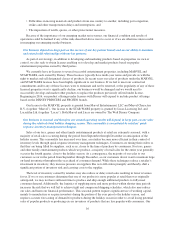Hasbro 2015 Annual Report Download - page 17
Download and view the complete annual report
Please find page 17 of the 2015 Hasbro annual report below. You can navigate through the pages in the report by either clicking on the pages listed below, or by using the keyword search tool below to find specific information within the annual report.
Each of our four product categories, namely boys, games, girls and preschool, generate greater than 10% of
our net revenues. For more information, including the amount of net revenues attributable to each of our four
product categories, see note 19 to our consolidated financial statements, which are included in Item 8 of this
Form 10-K.
Working Capital Requirements
Our working capital needs are financed through cash generated from operations, primarily through the sale
of toys and games and secondarily through our consumer products licensing operations, and, when necessary,
proceeds from short-term borrowings.
Our customer order patterns may vary from year to year largely due to fluctuations in the degree of
consumer acceptance of product lines, product availability, marketing strategies and inventory policies of
retailers, the dates of theatrical releases of major motion pictures for which we offer products, and changes in
overall economic conditions. As such, a disproportionate volume of our net revenues are earned during the third
and fourth quarters leading up to the retail industry’s holiday selling season, including Christmas. As a result,
comparisons of unshipped orders on any date with those at the same date in the prior year are not necessarily
indicative of our sales for that year. Moreover, quick response, or just-in-time, inventory management practices
result in a significant proportion of orders being placed for immediate delivery. Although the Company may
receive orders from customers in advance, it is general industry practice that these orders are subject to
amendment or cancellation by customers prior to shipment and, as such, the Company does not believe that these
unshipped orders, at any given date, are indicative of future sales. We expect that retailers will continue to follow
this strategy. As such, our business generally earns more revenue in the second half of the year compared to the
first half. In 2015, the second half of the year accounted for approximately 66% of full year revenues with the
third and fourth quarters each accounting for 33% of full year net revenues. The types of programs that we plan
to employ to promote sales in 2016 are substantially the same as those we employed in 2015 and in prior years.
Historically, we commit to the majority of our inventory production and advertising and marketing
expenditures for a given year prior to the peak fourth quarter retail selling season. Our accounts receivable
increase during the third and fourth quarter as customers increase their purchases to meet expected consumer
demand in the holiday season. Due to the concentrated timeframe of this selling period, payments for these
accounts receivable are generally not due until later in the fourth quarter or early in the first quarter of the
subsequent year. The timing difference between expenses paid and revenues collected sometimes makes it
necessary for us to borrow varying amounts during the year. During 2015, we utilized cash from our operations,
borrowings under our commercial paper program and uncommitted lines of credit to meet our cash flow
requirements.
Product Development and Royalties
Our success is dependent on continuous innovation in our branded-play and entertainment offerings and
requires continued development of new brands and products alongside the redesign of existing products to drive
consumer interest and market acceptance. Our toy and game products are developed by a global development
function, the costs of which are allocated to the selling entities which comprise our principal operating segments.
In 2015, 2014 and 2013, we incurred expenses of $242.9 million, $222.6 million and $207.6 million,
respectively, on activities related to the development, design and engineering of new products and their
packaging (including products brought to us by independent designers) and on the improvement or modification
of ongoing products. Much of this work is performed by our internal staff of designers, artists, model makers and
engineers.
In addition to the design and development work performed by our own staff, we deal with a number of
independent toy and game designers for whose designs and ideas we compete with other toy and game
manufacturers. Rights to such designs and ideas, when acquired by us, are usually exclusive and the agreements
require us to pay the designer a royalty on our net sales of the item. These designer royalty agreements, in some
cases, also provide for advance royalties and minimum guarantees.
6


